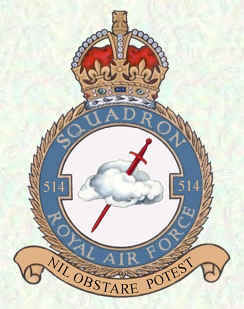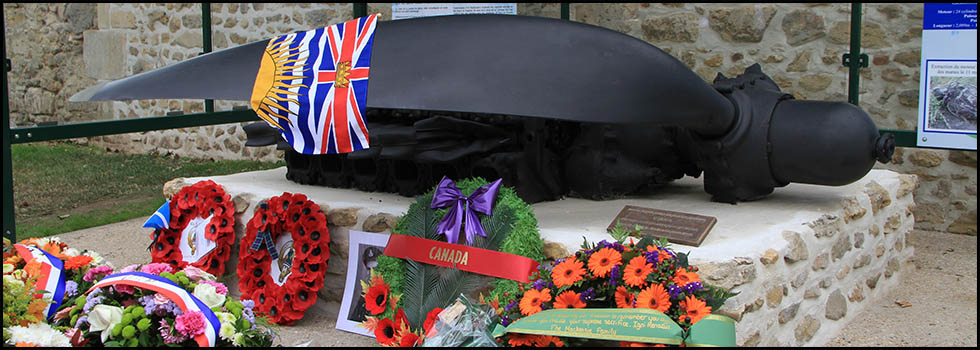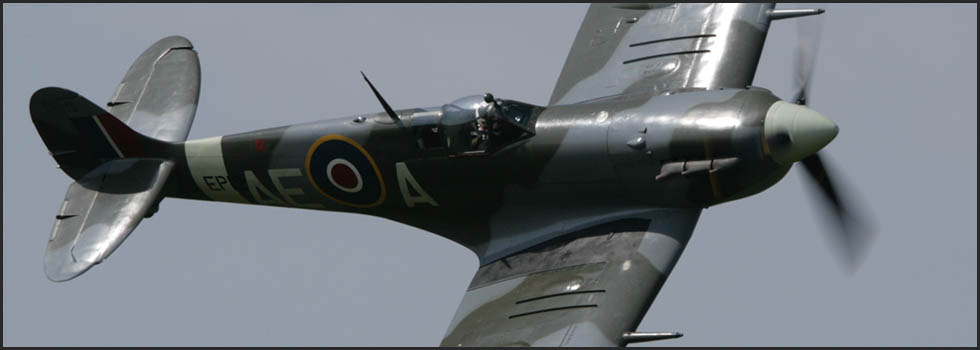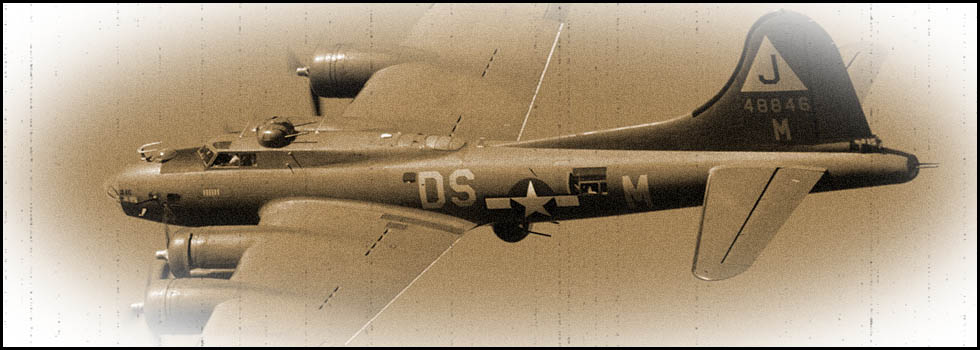14th April 2011
Sainte Eusoye (Oise)
Visit of F/S Eric G. RIPPINGALE family
En français

On 14th April 2011 we had the pleasure of welcoming Ms. Aissa Rippingale accompanied by her three sons Eric, Roland and Mark. This English family had decided to make the trip to France in memory of Flight Sergeant Eric G. Rippingale, bomb aimer aboard an Avro Lancaster II of the Royal Air Force during WWII.

On the night of 7th to 8th June 1944, 327 British bombers had the mission of destroyingGerman communications and transportation in France. Specifically aircraft of RAF 514 Squadron had to bomb the Massy-Palaiseau station, in Essonne. After taking off at 0:27 from their base of Waterbeach, England, the planes fully achieved their bombing mission and returned to their airfield.
Intercepted by a German night fighter Junker 88, the Lancaster II (serial LL 727 code squadron JI-C2) could no longer return to base because its right wing was on fire. The pilot, Flying Officer Louis Greenburgh, nevertheless managed to maintain the aircraft in flight in order to allow all the crew to bale out.
F/S Eric G. Rippingale, bomb aimer, quickly evacuated the aircraft and landed near Saulx-les-Chartreux (Essonne). Alone in the night and in an area he did not know, he wandered about until he met a young boy named Claude. This young Frenchman promptly informed Serge Boldrini, a member of the Resistance in the sector, who hid him in a safe place. This hiding place was a villa named "La Tour Prends Garde” and it was in this refuge that he met the young Aissa (Serge Boldrini’s sister) who brought him some food. Taken in charge by an escape network he got back to England. After the war F/S Rippingale came back to France and married Aissa. From their union would be born three children : Eric, Roland and Mark. As for Serge Boldrini (Sergeant FTP), he had a tragic end because he was killed by the Germans on 19th July 1944 on the platform of the metro station Pasteur in Paris. A plaque in his memory is visible there as well as at "La Tour Prends Garde."


Eric G. Rippingale died on 6th June 1991 aged 69.
All the crew managed to evacuate the stricken Lancaster and each one would know a different route.
W/O Leslie J.W. Sutton, copilot landed at Saulx-les-Chartreux where he was collected and hidden from the German authorities.
F/S Ronald Fox, navigator, baled out of the Lancaster and he was also collected after landing on French soil.
Sergeant Franck Collingwood, engineer, was taken prisoner by the Germans. He was sent to camp L7 (POW 80059).
Sergeant Frederick J. Carey, gunner, was also taken prisoner by German soldiers (POW 384).
Sergeant Richard J. Woosnam, rear gunner, was captured on 3rd July 1944 and sent to camp L7 (POW 424).
F/S Gordon H. Stromberg, wireless operator, seriously wounded, was found hanging from electric cables by his parachute. Transported by the Germans to a hospital in Amiens where he died on 9th June. He is buried in the St. Pierre cemetery in Amiens.
F/O Louis Greenburgh, pilot, managed to evacuate his plane before it crashed near the village of Sainte-Eusoye. He was then collected by the Levieille family in Sainte-Eusoye. He was then taken in charge by an escape network and was successively hidden in Puits-la-Vallée, Wavignies, Thury-sous-Clermont, Mouy and then in Paris and finally ended up in the camp of Fréteval (Loir-et-Cher). He stayed in this camp until its Liberation on 13th August 1944 by Allied troops.
For many years Mark Rippingale conducted research on the course of his father during the war and on this tragic mission of the night of 7th to 8th June 1944. Thanks to internet, he came into contact with Dominique Lecomte who provided information on the events which occurred after the plane crash. These multiple contacts decided the Rippingale family to come to France to visit the various places connected with the crash of the aircraft and to meet eyewitnesses.


On the occasion of this visit, the Rippingale family had the great joy of meeting Mrs. Micheline Lefebvre (nee Levieille). Mrs. Lefebvre, who at the time had only about ten years old nevertheless, took part in the helping of one of the hidden airmen. She vividly remembers bringing food to one of the crew members without unfortunately remembering his name. This was probably F/O L. Greenburgh, the pilot of the Lancaster. Micheline's husband, Pierre Lefebvre was also present at Sainte Eusoye on the nights of 7th to 8th June 1944. Then aged 14, he was awakened by the huge explosion produced by the impact of the Lancaster in the field. The next day, the young boy was able to approach the debris scattered on the area of the crash and he has a very precise recollection of this.
After having welcomed our English friends in the presence of Mr. Pierre Dugrosprez, mayor of the village and owner of the field we headed to the scene of the crash.


On the site, lots of debris of the Lancaster were found, reflecting the viloence of the crash. These pieces of the aircraft have a very important sentimental value for the Rimmpingale family. It is with some emotion that they left for England with a few pieces of the aircraft in which F/S Eric G. Rippingale made his last flight.
It was also at this very place that our guests wanted to give a gift to Dominique Lecomte in gratitude for his help in organizing this day.


We then went to a house located just near the crash site of the Lancaster. On the night of 7th to 8th June 1944 the huge explosion produced by the fall of the bomber had awakened the inhabitants with a start. One of the residents, in panic, jumped from the first floor of a window which is still visible today. Fortunately for him, he got away with more fear than harm.

For F/S Rippingale this mission was to end with his return to England after many vicissitudes. Unfortunately for F/S Gordon H. Stromberg, the emergency evacuation of the aircraft was fatal.
So the Rippingale family wished to go to the scene of his parachute descent and to the Saint Pierre cemetery in Amiens to pay their respects to him. We ended the day with a moment of reflection at the power lines where the unfortunate airman was found seriously injured still hanging under his parachute.






